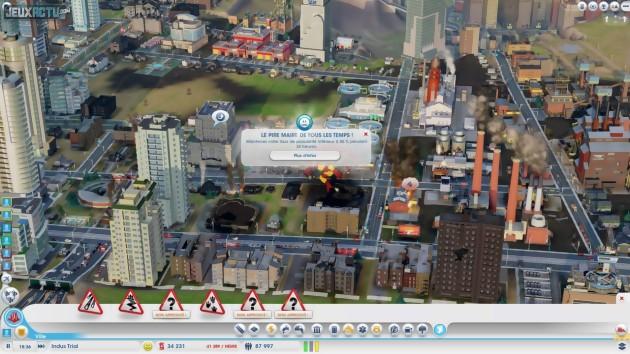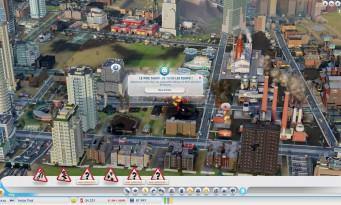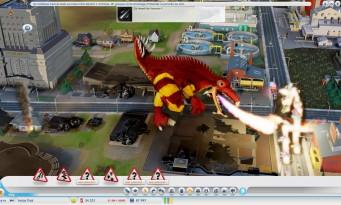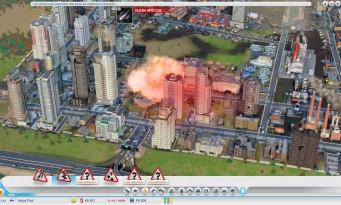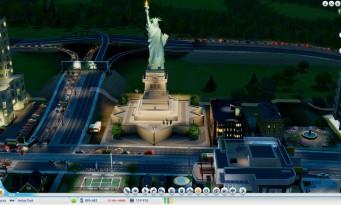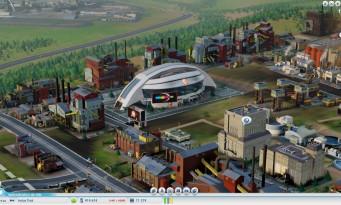 We will find as many reasons to complain about it as to welcome it, but the new SimCity actually forces us to play online, even if we want to quietly develop our city in our corner. This Diablo III-like system has yet to pass the test of fire, since the game will not be released in Europe for two days. Hope the servers hold up! For our part, we spent several days creating cities and exchanging between mayors, on a server dedicated to this purpose. And we will see that the experience was as pleasing as it was frustrating. As noted in our January preview, getting started is made easier by relatively subtle gameplay on the part of the game. each a proper name) regularly present their grievances to us, in the form of small quests to carry out. By adding a few industries because the unemployed are complaining, or a fire truck following a request from the firefighters, the novice player is thus guided without even realizing it. The graphics engine also does its job very well. Represented entirely in 3D, our cities appear more alive than ever. You can move freely from one place to another, zoom in as closely as possible to admire the details, admire the diurnal and nocturnal cycles, and even click on a pedestrian or a vehicle to automatically follow its movements. In terms of small graphic refinements, note the presence of various filters to be applied to change the atmosphere of the image (film noir, sepia, desaturated, etc.) and that of a model effect (of the "tilt-shift " for connoisseurs) which reinforces the impression of being in front of a miniature city. In maximum zoom the blur is unfortunately too pronounced on the foreground, but it remains a detail. The interface is almost flawless. The information screens are numerous but easily accessible and, above all, are displayed in light, elegant and relaxing tones. The city is adorned with white, to enhance the readability of the various colored graphics. A zen atmosphere that helps to pass the flood of information provided.
We will find as many reasons to complain about it as to welcome it, but the new SimCity actually forces us to play online, even if we want to quietly develop our city in our corner. This Diablo III-like system has yet to pass the test of fire, since the game will not be released in Europe for two days. Hope the servers hold up! For our part, we spent several days creating cities and exchanging between mayors, on a server dedicated to this purpose. And we will see that the experience was as pleasing as it was frustrating. As noted in our January preview, getting started is made easier by relatively subtle gameplay on the part of the game. each a proper name) regularly present their grievances to us, in the form of small quests to carry out. By adding a few industries because the unemployed are complaining, or a fire truck following a request from the firefighters, the novice player is thus guided without even realizing it. The graphics engine also does its job very well. Represented entirely in 3D, our cities appear more alive than ever. You can move freely from one place to another, zoom in as closely as possible to admire the details, admire the diurnal and nocturnal cycles, and even click on a pedestrian or a vehicle to automatically follow its movements. In terms of small graphic refinements, note the presence of various filters to be applied to change the atmosphere of the image (film noir, sepia, desaturated, etc.) and that of a model effect (of the "tilt-shift " for connoisseurs) which reinforces the impression of being in front of a miniature city. In maximum zoom the blur is unfortunately too pronounced on the foreground, but it remains a detail. The interface is almost flawless. The information screens are numerous but easily accessible and, above all, are displayed in light, elegant and relaxing tones. The city is adorned with white, to enhance the readability of the various colored graphics. A zen atmosphere that helps to pass the flood of information provided.
When we get to town...
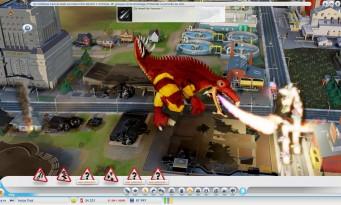 Beyond these finally quite cosmetic considerations, it is still necessary to dissect the heart of the gameplay. The basic fundamentals have not changed: it is still a question of building RCI zones (residents, businesses, industries) in order to attract as many people as possible to the city. So we start by placing roads, which are more important than ever. While streets and avenues can respectively be upgraded over time (in order to increase road traffic and the density of buildings bordering them), it is not possible to move from one category to another. Nor to delete a road without automatically destroying all the buildings connected to it. The key to success therefore lies, among other things, in a thoughtful placement of the roads from the first minutes of play. Especially since now, the electricity, water and sewer networks automatically follow their routes. But the real novelty concerns the appearance of curved roads. Budding artists will be able to have a field day and create magnificent bends and other roundabouts. But be warned: they will lose a lot of space and will not be able to optimize the population density. The natural solution would then be to create "flat" residential areas and others dedicated to buildings. But here we come up against what is undoubtedly the biggest flaw of the game: the too limited size of the fields. The regression from Sim City 4 is obvious and quite incomprehensible (although it is certainly a technical limitation). Two hours are enough to fill a map, and then all that remains is to fight with demolition / reconstruction to try to grab every square centimeter. Suddenly, the curved roads which we welcomed the appearance previously become almost anecdotal, as it is suicidal to use them. To tell the truth, one has the impression that the whole of the game was developed without taking into account the exiguity of the grounds. For example, the filling of groundwater tables is generally not enough to compensate for the pumping of water. We must then regularly shave entire neighborhoods, just to place a new pump. It doesn't really make sense... In general, it is advisable not to get too attached to your city since the whole game is actually based on its multi-city aspect.
Beyond these finally quite cosmetic considerations, it is still necessary to dissect the heart of the gameplay. The basic fundamentals have not changed: it is still a question of building RCI zones (residents, businesses, industries) in order to attract as many people as possible to the city. So we start by placing roads, which are more important than ever. While streets and avenues can respectively be upgraded over time (in order to increase road traffic and the density of buildings bordering them), it is not possible to move from one category to another. Nor to delete a road without automatically destroying all the buildings connected to it. The key to success therefore lies, among other things, in a thoughtful placement of the roads from the first minutes of play. Especially since now, the electricity, water and sewer networks automatically follow their routes. But the real novelty concerns the appearance of curved roads. Budding artists will be able to have a field day and create magnificent bends and other roundabouts. But be warned: they will lose a lot of space and will not be able to optimize the population density. The natural solution would then be to create "flat" residential areas and others dedicated to buildings. But here we come up against what is undoubtedly the biggest flaw of the game: the too limited size of the fields. The regression from Sim City 4 is obvious and quite incomprehensible (although it is certainly a technical limitation). Two hours are enough to fill a map, and then all that remains is to fight with demolition / reconstruction to try to grab every square centimeter. Suddenly, the curved roads which we welcomed the appearance previously become almost anecdotal, as it is suicidal to use them. To tell the truth, one has the impression that the whole of the game was developed without taking into account the exiguity of the grounds. For example, the filling of groundwater tables is generally not enough to compensate for the pumping of water. We must then regularly shave entire neighborhoods, just to place a new pump. It doesn't really make sense... In general, it is advisable not to get too attached to your city since the whole game is actually based on its multi-city aspect.
Sim Little Cities
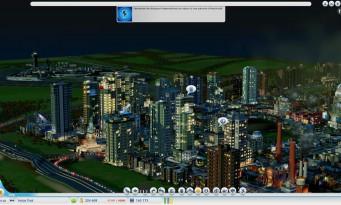 Because that's what the mandatory Internet connection is officially for: trade and exchange with other cities, which belong to us or are run by other players. The largest regions can accommodate up to sixteen settlements, although not all of them can directly communicate with each other due to geographical constraints that cannot be overcome (impossible to build a bridge or a road on the Region map). To make the most of this aspect of the game, it is advisable to build specialized cities. In mining, drilling, commerce, electronics, culture or casinos. Thus, we can sell certain resources while taking advantage of surpluses (including employees, students, firefighters or tourists) from neighboring towns. We inevitably think of the precursor Cities XL, in a little more successful. Moreover, it is also possible here to collaborate to build major projects, beneficial to the whole region: solar power plant, international airport, space center and archology. We still regret that in this context, some information is more difficult to find than in the interface dedicated to "solo" cities. And the asynchronous management of events – necessary so that each mayor can speed up time as he sees fit and go to bed when he wants – leads to some inconsistencies and misunderstandings. The game is not free of bugs either. , some of which can be very annoying. Let's quickly go over the spelling mistakes ("eault") and other locational blunders (the "solar power station" of the cities has nothing to do with the "solar power station" of the regions, it is sometimes necessary to understand "revenues" when the game displays "cost", or even "imports" instead of exports...). What seemed to us the most problematic concerns traffic management. Even with the largest avenues and maximized public transport, it seems impossible to escape traffic jams. And the power of the 3D engine which makes it possible to follow the progress of each inhabitant then turns against the game, since one can realize the often incoherent behavior of the vehicles. Watching your city burn because all the firefighters are stuck because of taxis driving around in circles is hardly pleasant. We could talk for a long time about the features of the game, as well as its qualities and its faults, since in all three cases they are very numerous (just like the DLCs which are already starting to rain...). But we will rather conclude by saying that SimCity is a game that is certainly imperfect, but oh so endearing. The recipe remains devilishly effective, and you can't help but regularly start a game in the hope of always going a little further, a little stronger, a little higher.
Because that's what the mandatory Internet connection is officially for: trade and exchange with other cities, which belong to us or are run by other players. The largest regions can accommodate up to sixteen settlements, although not all of them can directly communicate with each other due to geographical constraints that cannot be overcome (impossible to build a bridge or a road on the Region map). To make the most of this aspect of the game, it is advisable to build specialized cities. In mining, drilling, commerce, electronics, culture or casinos. Thus, we can sell certain resources while taking advantage of surpluses (including employees, students, firefighters or tourists) from neighboring towns. We inevitably think of the precursor Cities XL, in a little more successful. Moreover, it is also possible here to collaborate to build major projects, beneficial to the whole region: solar power plant, international airport, space center and archology. We still regret that in this context, some information is more difficult to find than in the interface dedicated to "solo" cities. And the asynchronous management of events – necessary so that each mayor can speed up time as he sees fit and go to bed when he wants – leads to some inconsistencies and misunderstandings. The game is not free of bugs either. , some of which can be very annoying. Let's quickly go over the spelling mistakes ("eault") and other locational blunders (the "solar power station" of the cities has nothing to do with the "solar power station" of the regions, it is sometimes necessary to understand "revenues" when the game displays "cost", or even "imports" instead of exports...). What seemed to us the most problematic concerns traffic management. Even with the largest avenues and maximized public transport, it seems impossible to escape traffic jams. And the power of the 3D engine which makes it possible to follow the progress of each inhabitant then turns against the game, since one can realize the often incoherent behavior of the vehicles. Watching your city burn because all the firefighters are stuck because of taxis driving around in circles is hardly pleasant. We could talk for a long time about the features of the game, as well as its qualities and its faults, since in all three cases they are very numerous (just like the DLCs which are already starting to rain...). But we will rather conclude by saying that SimCity is a game that is certainly imperfect, but oh so endearing. The recipe remains devilishly effective, and you can't help but regularly start a game in the hope of always going a little further, a little stronger, a little higher.
